Abstract
1 The effects of thyroid state on the properties of adrenoceptors mediating inotropic and chronotropic responses of the rat heart were assessed on the basis of the relative potencies of alpha- and beta-adrenoceptor agonists, the effects of alpha- and beta-adrenoceptor antagonists and the tissue uptake of [3H]-phenoxybenzamine ([3H]-PB). 2 In isolated, electrically driven left atria the ratio of the inotropic potencies of isoprenaline and phenylephrine and the inhibitory potency of propranolol (40nM-4 muM) were significantly reduced after thyroidectomy and were moderately increased after thyroxine treatment of control rats. 3 Block of inotropic responses to noradrenaline and to phenylephrine by PB (7.3 nM-7.3 muM) and the tissue uptake of [3H]-PB were significantly greater in preparations from thyroidectomized than in those from control or from thyroxine treated rats. alpha-Adrenoceptor inhibition by phentolamine (0.26-2.6 muM) also increased after thyroidectomy, and phentolamine effectively protected alpha-adrenoceptors from block by and binding of [3H]-PB. 4 The beta1-receptor antagonist H 93/26 (0.1 muM) significantly potentiated alpha-adrenoceptor blockade by PB in hypothyroid but not in control preparations. 5 In spontaneously beating right atria the chronotropic potency of agonists and the effects of antagonists were altered in the same way as were inotropic responses and the slope of the agonist concentration-response curves were significantly reduced after thyroidectomy. Effects of agonists and antagonists were not significantly influenced by thyroxine treatment. 6 Changes in the effects and tissue uptake of sympathomimetic drugs observed after thyroidectomy were reversed to or beyond control levels by thyroid hormone treatment of thyroidectomized animals. 7 The results presented are interpreted as indicating a thyroid hormone-dependent interconversion of myocardial alpha- and beta-adrenoceptors. It is suggested that this interconversion is similar to that observed earlier in frog hearts at different temperatures, and that both effects may reflect an allosteric transition between two forms of a single basic structure.
Full text
PDF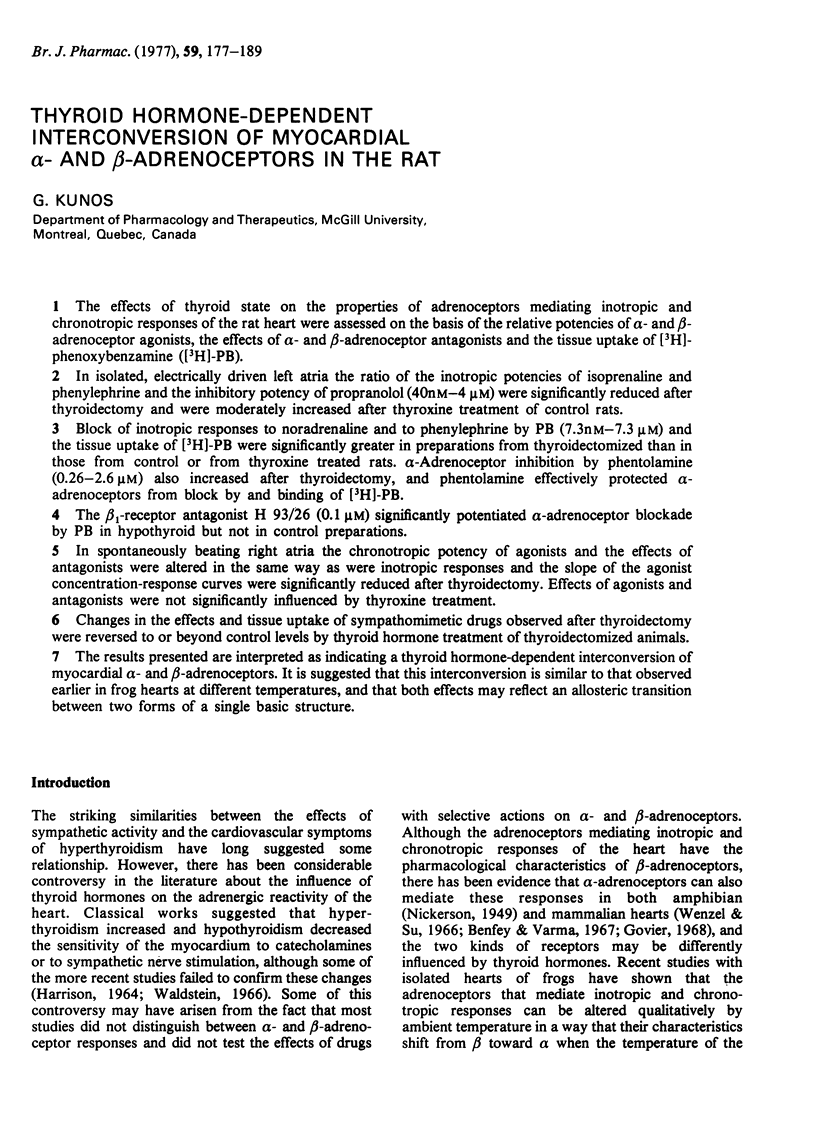
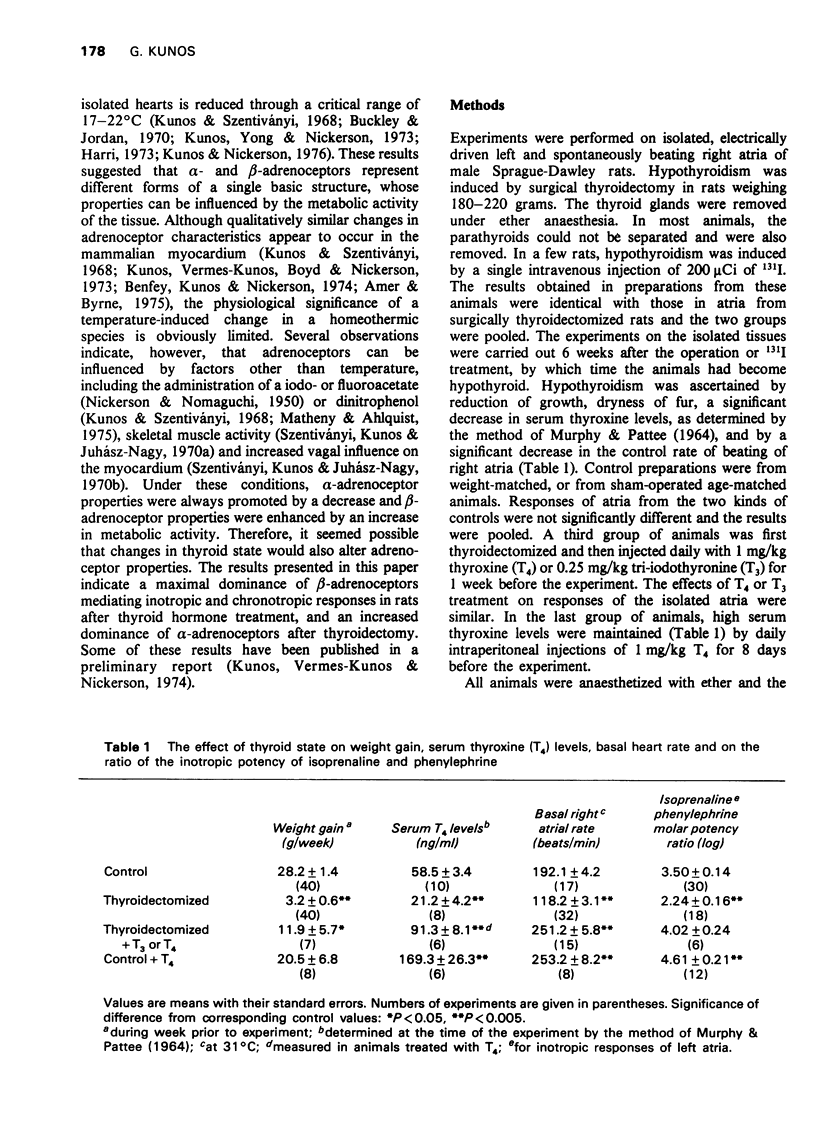
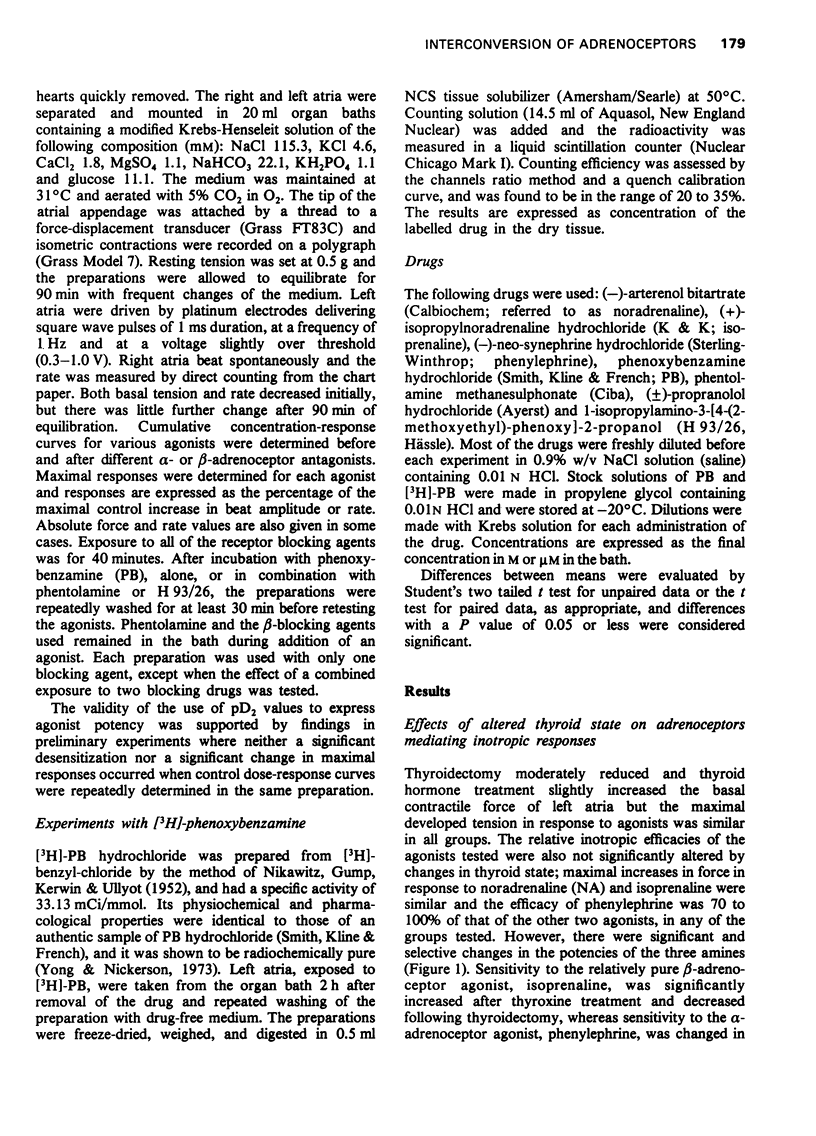
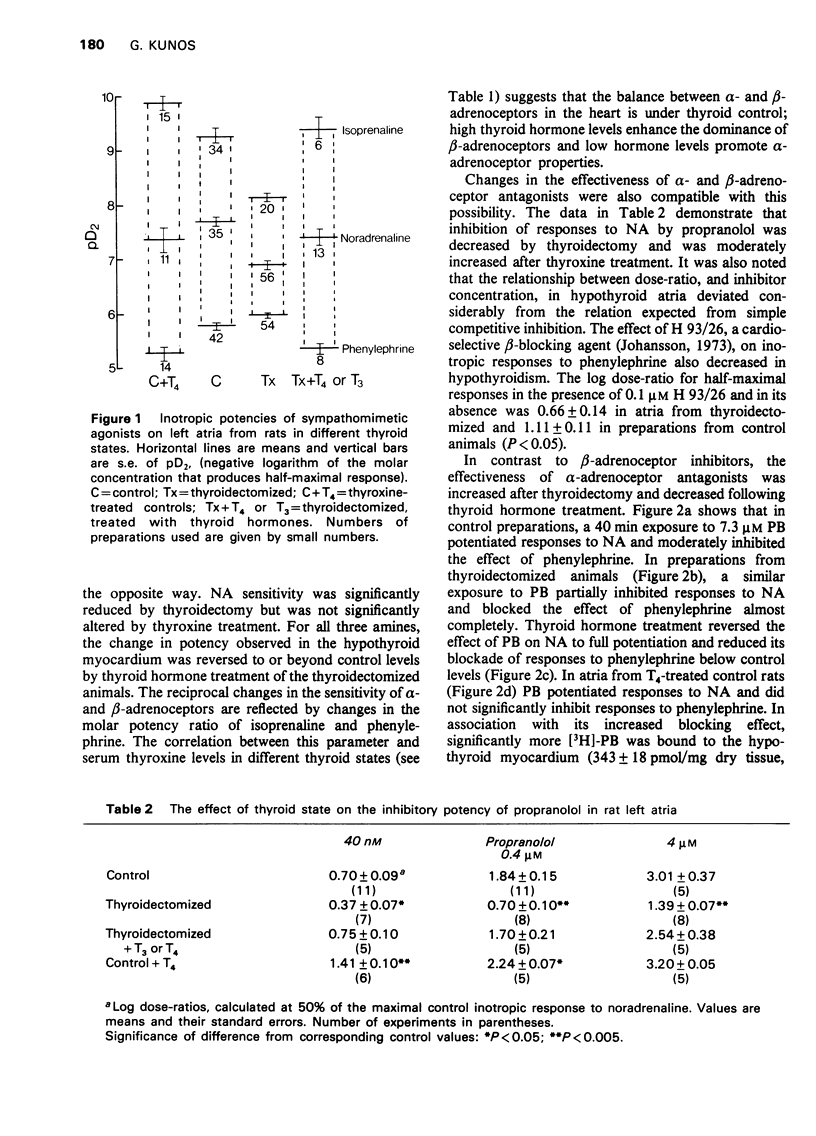
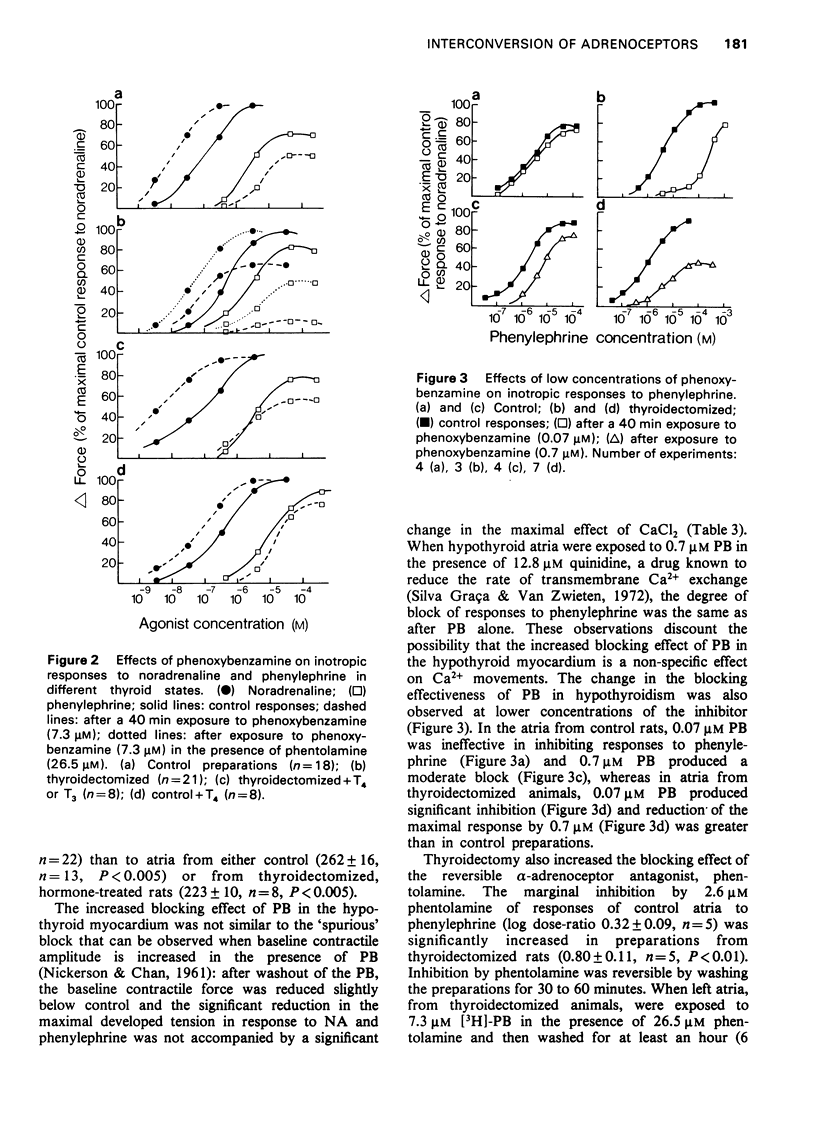
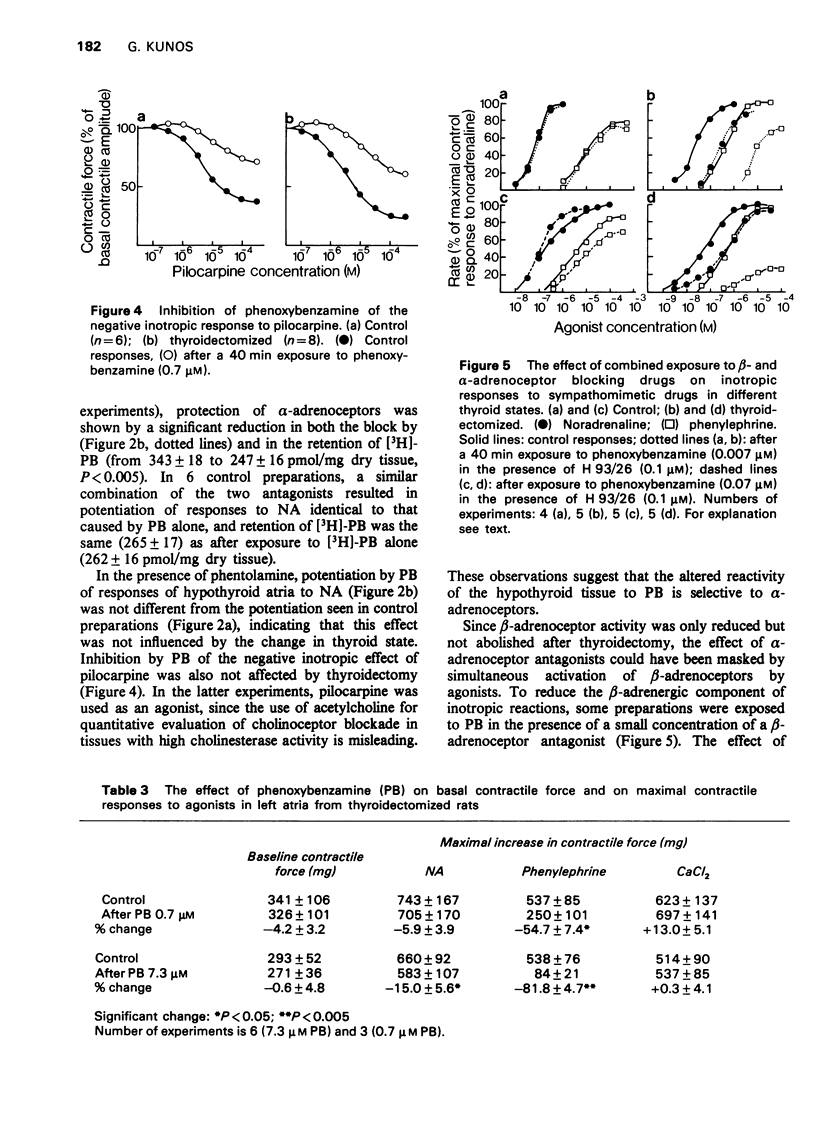
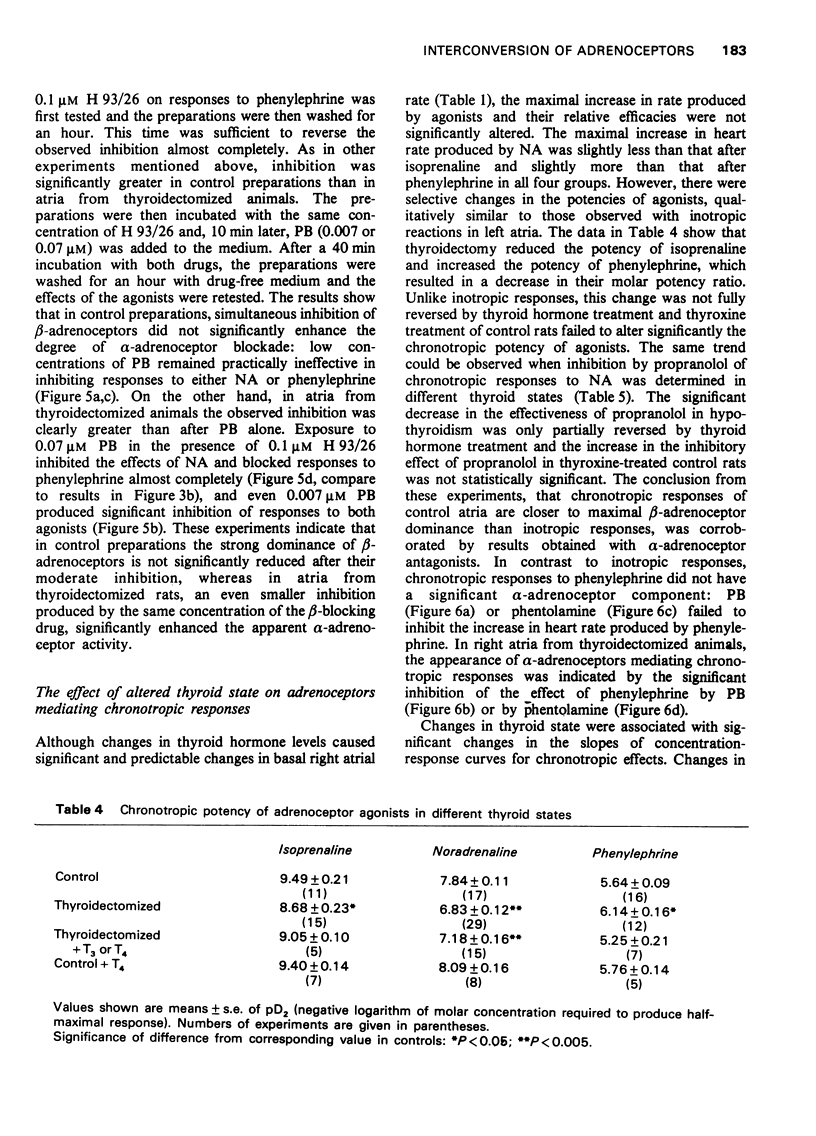
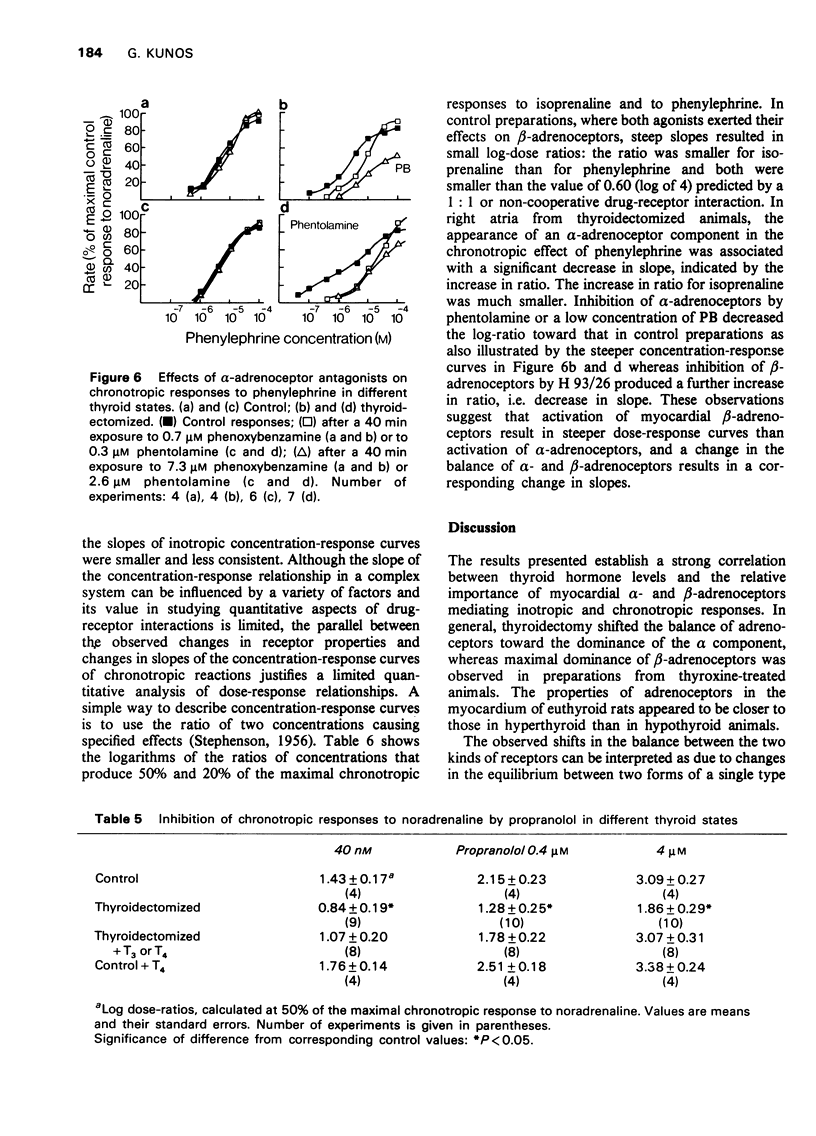

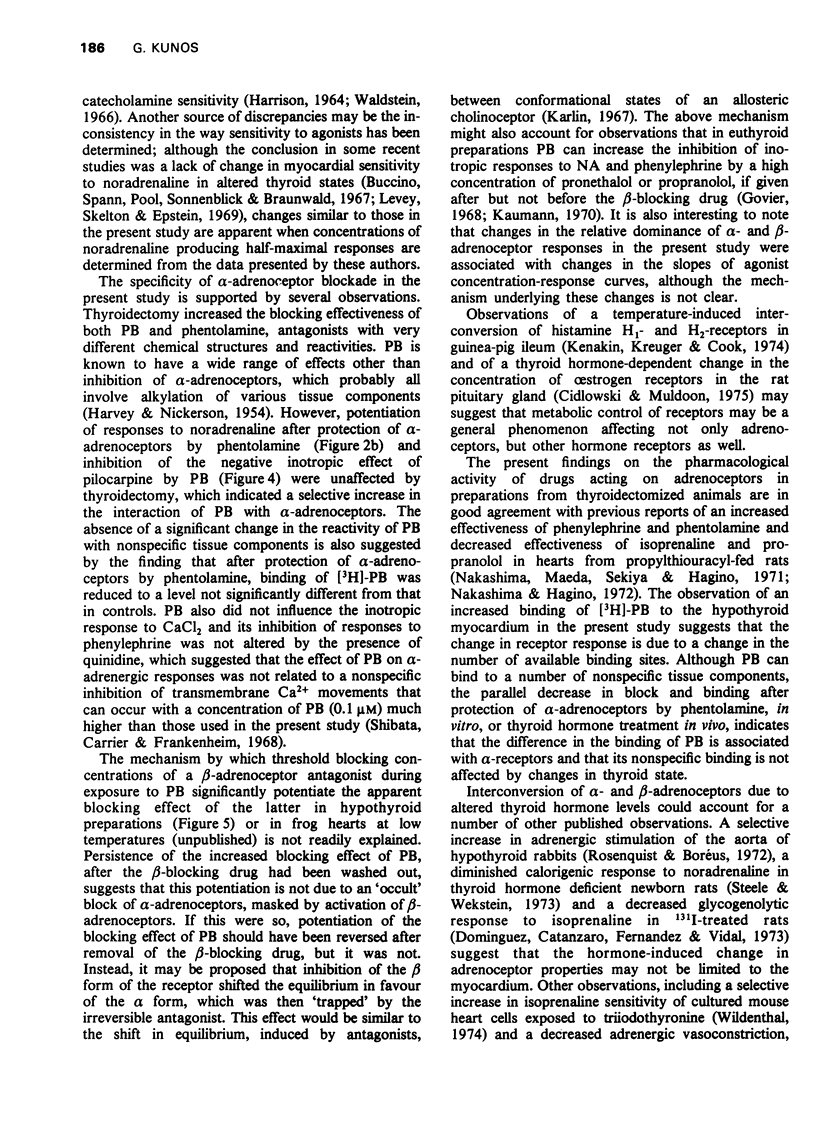
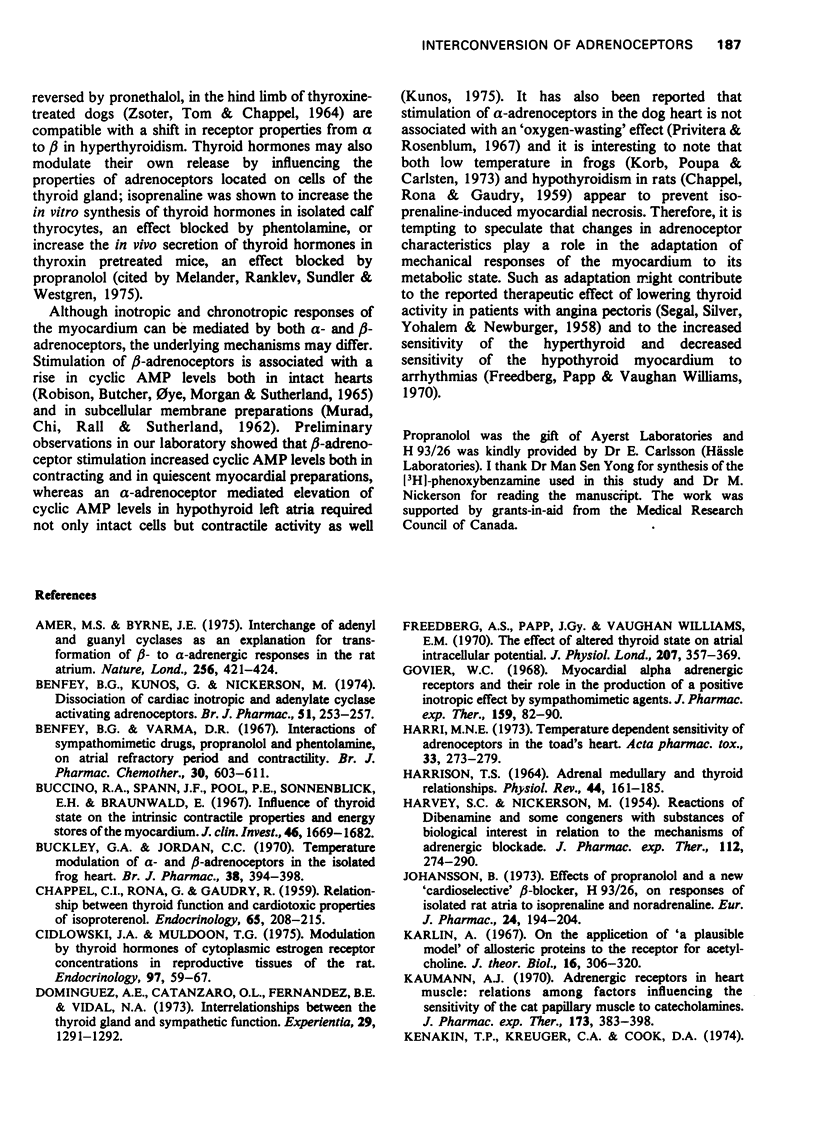
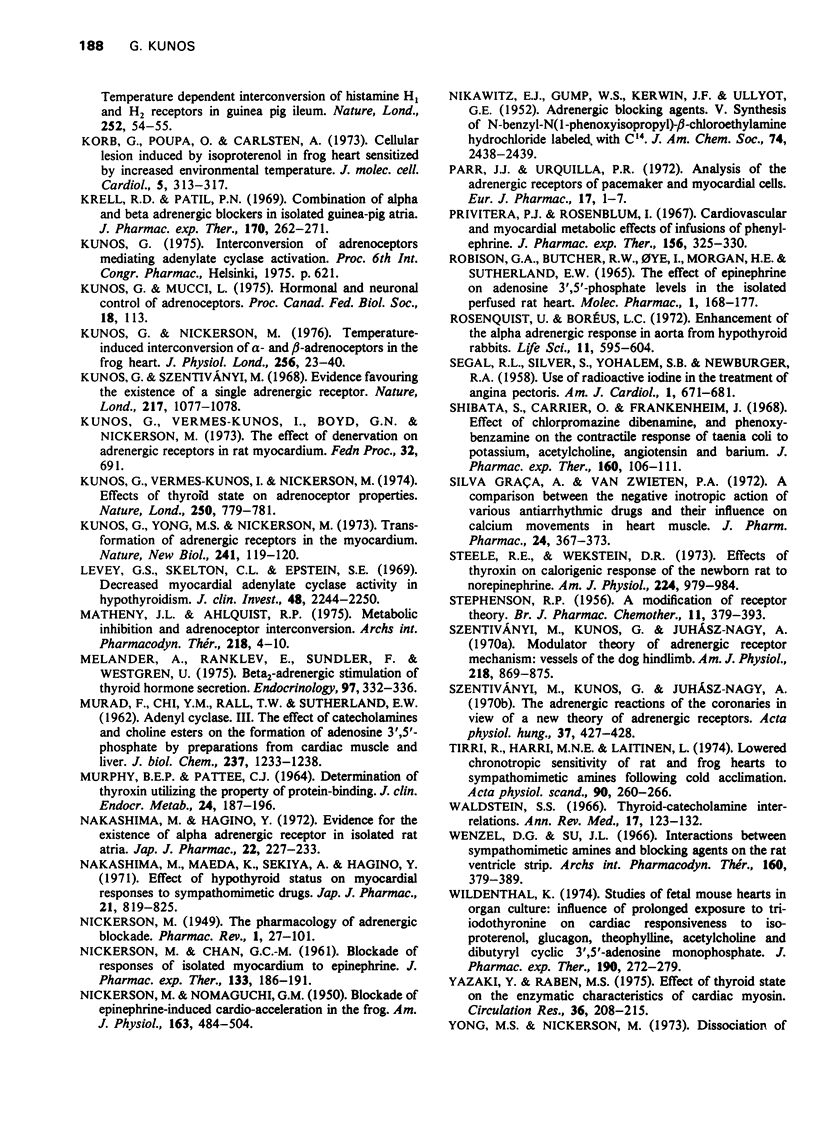
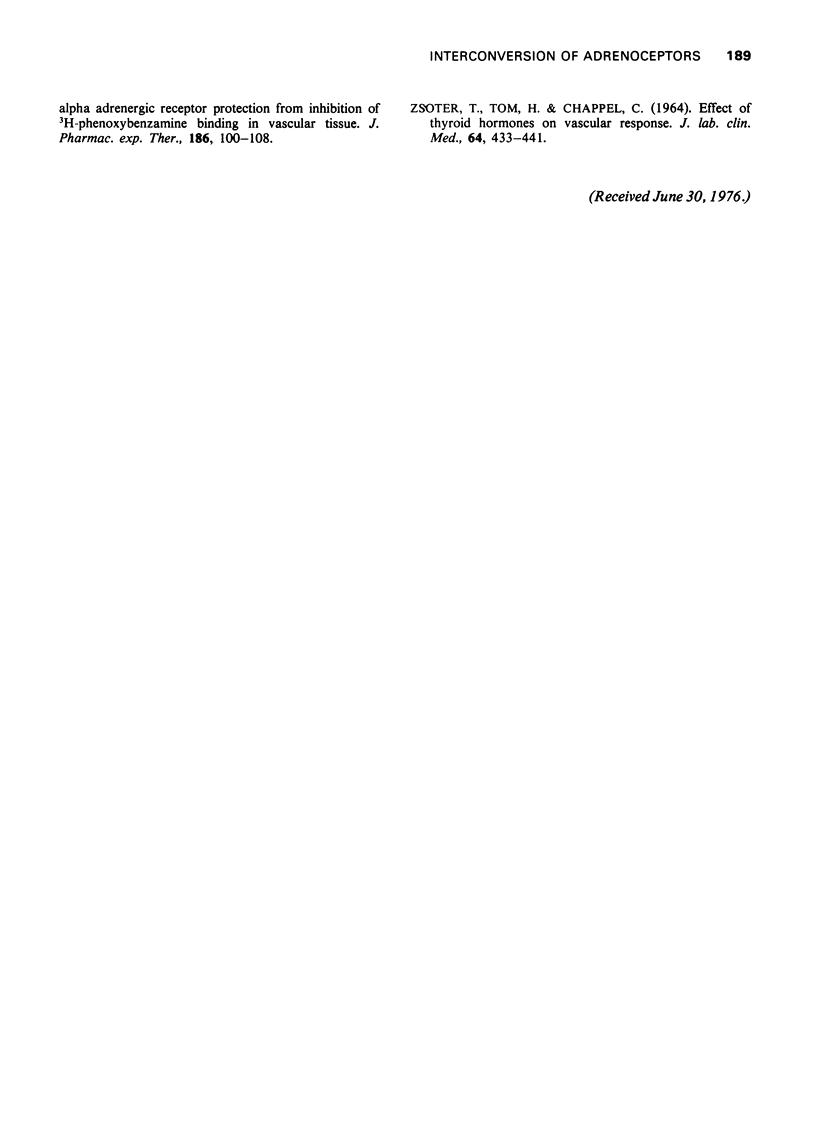
Selected References
These references are in PubMed. This may not be the complete list of references from this article.
- Amer M. S., Byrne J. E. Interchange of adenyl and guanyl cyclases as an explanation for transformation of Beta- to alpha-adrenergic responses in the rat atrium. Nature. 1975 Jul 31;256(5516):421–424. doi: 10.1038/256421a0. [DOI] [PubMed] [Google Scholar]
- Benfey B. G., Kunos G., Nickerson M. Dissociation of cardiac inotropic and adenylate cyclast activating adrenoceptors. Br J Pharmacol. 1974 Jun;51(2):253–257. doi: 10.1111/j.1476-5381.1974.tb09655.x. [DOI] [PMC free article] [PubMed] [Google Scholar]
- Benfey B. G., Varma D. R. Interactions of sympathomimetic drugs, propranolol and phentolamine, on atrial refractory period and contractility. Br J Pharmacol Chemother. 1967 Aug;30(3):603–611. doi: 10.1111/j.1476-5381.1967.tb02166.x. [DOI] [PMC free article] [PubMed] [Google Scholar]
- Buccino R. A., Spann J. F., Jr, Pool P. E., Sonnenblick E. H., Braunwald E. Influence of the thyroid state on the intrinsic contractile properties and energy stores of the myocardium. J Clin Invest. 1967 Oct;46(10):1669–1682. doi: 10.1172/JCI105658. [DOI] [PMC free article] [PubMed] [Google Scholar]
- Buckley G. A., Jordan C. C. Temperature modulation of alpha- and beta-adrenoceptors in the isolated frog heart. Br J Pharmacol. 1970 Feb;38(2):394–398. [PMC free article] [PubMed] [Google Scholar]
- CHAPPEL C. I., RONA G., GAUDRY R. Relationship between thyroid function and cardiotoxic properties of isoproterenol. Endocrinology. 1959 Aug;65(2):208–215. doi: 10.1210/endo-65-2-208. [DOI] [PubMed] [Google Scholar]
- Cidlowski J. A., Muldoon T. G. Modulation by thyroid hormones of cytoplasmic estrogen receptor concentrations in reproductive tissues of the rat. Endocrinology. 1975 Jul;97(1):59–67. doi: 10.1210/endo-97-1-59. [DOI] [PubMed] [Google Scholar]
- Freedberg A. S., Papp J. G., Williams E. M. The effect of altered thyroid state on atrial intracellular potentials. J Physiol. 1970 Apr;207(2):357–369. doi: 10.1113/jphysiol.1970.sp009066. [DOI] [PMC free article] [PubMed] [Google Scholar]
- Govier W. C. Myocardial alpha adrenergic receptors and their role in the production of a positive inotropic effect by sympathomimetic agents. J Pharmacol Exp Ther. 1968 Jan;159(1):82–90. [PubMed] [Google Scholar]
- Graça A. S., Van Zwieten P. A. A comparison between the negative inotropic action of various antiarrhythmic drugs and their influence on calcium movements in heart muscle. J Pharm Pharmacol. 1972 May;24(5):367–373. doi: 10.1111/j.2042-7158.1972.tb09009.x. [DOI] [PubMed] [Google Scholar]
- HARRISON T. S. ADRENAL MEDULLARY AND THYROID RELATIONSHIPS. Physiol Rev. 1964 Apr;44:161–185. doi: 10.1152/physrev.1964.44.2.161. [DOI] [PubMed] [Google Scholar]
- HARVEY S. C., NICKERSON M. Reactions of dibenamine and some congeners with substances of biological interest in relation to the mechanism of adrenergic blockade. J Pharmacol Exp Ther. 1954 Nov;112(3):274–290. [PubMed] [Google Scholar]
- Harri M. N. Temperature-dependent sensitivity of adrenoreceptors in the toad's heart. Acta Pharmacol Toxicol (Copenh) 1973;33(4):273–279. doi: 10.1111/j.1600-0773.1973.tb01527.x. [DOI] [PubMed] [Google Scholar]
- Johansson B. Effects of propranolol and a new 'cardioselective' beta-blocker, H 93-26, on responses of isolated rat atria to isoprenaline and noradrenaline. Eur J Pharmacol. 1973 Nov;24(2):194–204. doi: 10.1016/0014-2999(73)90072-1. [DOI] [PubMed] [Google Scholar]
- Karlin A. On the application of "a plausible model" of allosteric proteins to the receptor for acetylcholine. J Theor Biol. 1967 Aug;16(2):306–320. doi: 10.1016/0022-5193(67)90011-2. [DOI] [PubMed] [Google Scholar]
- Kaumann A. J. Adrenergic receptors in heart muscle: relations among factors influencing the sensitivity of the cat papillary muscle to catecholamines. J Pharmacol Exp Ther. 1970 Jun;173(2):383–398. [PubMed] [Google Scholar]
- Kenakin T. P., Krueger C. A., Cook D. A. Temperature-dependent interconversion of histamine H1 and H2 receptors in guinea pig ileum. Nature. 1974 Nov 1;252(5478):54–55. doi: 10.1038/252054a0. [DOI] [PubMed] [Google Scholar]
- Korb G., Poupa O., Carlsten A. Cellular lesions induced by isoproterenol in frog heart sensitized by increased environmental temperature. J Mol Cell Cardiol. 1973 Aug;5(4):313–317. doi: 10.1016/0022-2828(73)90024-2. [DOI] [PubMed] [Google Scholar]
- Krell R. D., Patil P. N. Combinations of alpha and beta adrenergic blockers in isolated guinea-pig atria. J Pharmacol Exp Ther. 1969 Dec;170(2):262–271. [PubMed] [Google Scholar]
- Kunos G., Nickerson M. Temperature-induced interconversion of alpha-and beta-adrenoceptors in the frog heart. J Physiol. 1976 Mar;256(1):23–40. doi: 10.1113/jphysiol.1976.sp011309. [DOI] [PMC free article] [PubMed] [Google Scholar]
- Kunos G., Szentivanyi M. Evidence favouring the existence of a single adrenergic receptor. Nature. 1968 Mar 16;217(5133):1077–1078. doi: 10.1038/2171077a0. [DOI] [PubMed] [Google Scholar]
- Kunos G., Vermes-Kunos I., Nickerson M. Effects of thyroid state on adrenoceptor properties. Nature. 1974 Aug 30;250(5469):779–781. doi: 10.1038/250779a0. [DOI] [PubMed] [Google Scholar]
- Kunos G., Yong M. S., Nickerson M. Transformation of adrenergic receptors in the myocardium. Nat New Biol. 1973 Jan 24;241(108):119–120. doi: 10.1038/newbio241119a0. [DOI] [PubMed] [Google Scholar]
- Levey G. S., Skelton C. L., Epstein S. E. Decreased myocardial adenyl cyclase activity in hypothyroidism. J Clin Invest. 1969 Dec;48(12):2244–2250. doi: 10.1172/JCI106190. [DOI] [PMC free article] [PubMed] [Google Scholar]
- MURAD F., CHI Y. M., RALL T. W., SUTHERLAND E. W. Adenyl cyclase. III. The effect of catecholamines and choline esters on the formation of adenosine 3',5'-phosphate by preparations from cardiac muscle and liver. J Biol Chem. 1962 Apr;237:1233–1238. [PubMed] [Google Scholar]
- MURPHY B. E., PATTEE C. J. DETERMINATION OF THYROXINE UTILIZING THE PROPERTY OF PROTEIN-BINDING. J Clin Endocrinol Metab. 1964 Feb;24:187–196. doi: 10.1210/jcem-24-2-187. [DOI] [PubMed] [Google Scholar]
- Matheny J. L., Ahlquist R. P. Metabolic inhibition and adrenoceptor interconversion. Arch Int Pharmacodyn Ther. 1975 Nov;218(1):4–10. [PubMed] [Google Scholar]
- Melander A., Ranklev E., Sundler F., Westgren U. Beta2-adrenergic stimulation of thyroid hormone secretion. Endocrinology. 1975 Aug;97(2):332–336. doi: 10.1210/endo-97-2-332. [DOI] [PubMed] [Google Scholar]
- NICKERSON M., CHAN G. C. Blockade of responses of isolated myocardium to epinephrine. J Pharmacol Exp Ther. 1961 Aug;133:186–191. [PubMed] [Google Scholar]
- NICKERSON M., NOMAGUCHI G. M. Blockade of epinephrine-induced cardio-acceleration in the frog. Am J Physiol. 1950 Dec;163(3):484–504. doi: 10.1152/ajplegacy.1950.163.3.484. [DOI] [PubMed] [Google Scholar]
- Nakashima M., Hagino Y. Evidence for the existence of alpha adrenergic receptor in isolated rat atria. Jpn J Pharmacol. 1972 Apr;22(2):227–233. doi: 10.1254/jjp.22.227. [DOI] [PubMed] [Google Scholar]
- Nakashima M., Maeda K., Sekiya A., Hagino Y. Effect of hypothyroid status on myocardial responses to sympathomimetic drugs. Jpn J Pharmacol. 1971 Dec;21(6):819–825. doi: 10.1254/jjp.21.819. [DOI] [PubMed] [Google Scholar]
- Parr J. J., Urquilla P. R. Analysis of the adrenergic receptors of pacemaker and myocardial cells. Eur J Pharmacol. 1972 Jan;17(1):1–7. doi: 10.1016/0014-2999(72)90261-0. [DOI] [PubMed] [Google Scholar]
- Privitera P. J., Rosenblum I. Cardiovascular and myocardial metabolic effects of infusions of phenylephrine. J Pharmacol Exp Ther. 1967 May;156(2):325–330. [PubMed] [Google Scholar]
- Robison G. A., Butcher R. W., Oye I., Morgan H. E., Sutherland E. W. The effect of epinephrine on adenosine 3', 5'-phosphate levels in the isolated perfused rat heart. Mol Pharmacol. 1965 Sep;1(2):168–177. [PubMed] [Google Scholar]
- Rosenqvist U., Boréus L. O. Enhancement of the alpha adrenergic response in aorta from hypothyroid rabbits. Life Sci I. 1972 Jun 15;11(12):595–604. doi: 10.1016/0024-3205(72)90195-6. [DOI] [PubMed] [Google Scholar]
- Rothstein H., Worgul B., Briggs R., Van Buskirk R. Triiodothyronine and thyroxine: induction of mitosis in adult frogs. Experientia. 1973 Oct 15;29(10):1291–1292. doi: 10.1007/BF01935124. [DOI] [PubMed] [Google Scholar]
- SEGAL R. L., SILVER S., YOHALEM S. B., NEWBURGER R. A. Use of radioactive iodine in the treatment of angina pectoris. Am J Cardiol. 1958 Jun;1(6):671–681. doi: 10.1016/0002-9149(58)90157-7. [DOI] [PubMed] [Google Scholar]
- STEPHENSON R. P. A modification of receptor theory. Br J Pharmacol Chemother. 1956 Dec;11(4):379–393. doi: 10.1111/j.1476-5381.1956.tb00006.x. [DOI] [PMC free article] [PubMed] [Google Scholar]
- Shibata S., Carrier O., Jr, Frankenheim J. Effect of chlorpromazine, dibenamine and phenoxybenzamine on the contractile response of taenia coli to potassium, acetylcholine, angiotensin and barium. J Pharmacol Exp Ther. 1968 Mar;160(1):106–111. [PubMed] [Google Scholar]
- Steele R. E., Wekstein D. R. Effects of throxine on calorigenic response of the newborn rat to norepinephrine. Am J Physiol. 1973 Apr;224(4):979–984. doi: 10.1152/ajplegacy.1973.224.4.979. [DOI] [PubMed] [Google Scholar]
- Szentiványi M., Kunos G., Juhász-Nagy A. Modulator theory of adrenergic receptor mechanism: vessels of the dog hindlimb. Am J Physiol. 1970 Mar;218(3):869–875. doi: 10.1152/ajplegacy.1970.218.3.869. [DOI] [PubMed] [Google Scholar]
- Tirri R., Harri M. N., Laitinen L. Lowered chronotropic sensitivity of rat and frog hearts to sympathomimetic amines following cold acclimation. Acta Physiol Scand. 1974 Jan;90(1):260–266. doi: 10.1111/j.1748-1716.1974.tb05585.x. [DOI] [PubMed] [Google Scholar]
- Waldstein S. S. Thyroid-catecholamine interrelations. Annu Rev Med. 1966;17:123–132. doi: 10.1146/annurev.me.17.020166.001011. [DOI] [PubMed] [Google Scholar]
- Wenzel D. G., Su J. L. Interactions between sympathomimetic amines and blocking agents on the rat ventricle strip. Arch Int Pharmacodyn Ther. 1966 Apr;160(2):379–389. [PubMed] [Google Scholar]
- Wildenthal K. Studies of fetal mouse hearts in organ culture: influence of prolonged exposure to triiodothyronine on cardiac responsiveness to isoproterenol, glucagon, theophylline, acetylcholine and dibutyryl cyclic 3',5'-adenosine monophosphate. J Pharmacol Exp Ther. 1974 Aug;190(2):272–279. [PubMed] [Google Scholar]
- Yazaki Y., Raben M. S. Effect of the thyroid state on the enzymatic characteristics of cardiac myosin. A difference in behavior of rat and rabbit cardiac myosin. Circ Res. 1975 Jan;36(1):208–215. doi: 10.1161/01.res.36.1.208. [DOI] [PubMed] [Google Scholar]
- Yong M. S., Nickerson M. Dissociation of alpha adrenergic receptor protection from inhibition of H-phenoxybenlamine binding in vascular tissue. J Pharmacol Exp Ther. 1973 Jul;186(1):100–108. [PubMed] [Google Scholar]
- ZSOTER T., TOM H., CHAPPEL C. EFFECT OF THYROID HORMONES ON VASCULAR RESPONSE. J Lab Clin Med. 1964 Sep;64:433–441. [PubMed] [Google Scholar]


